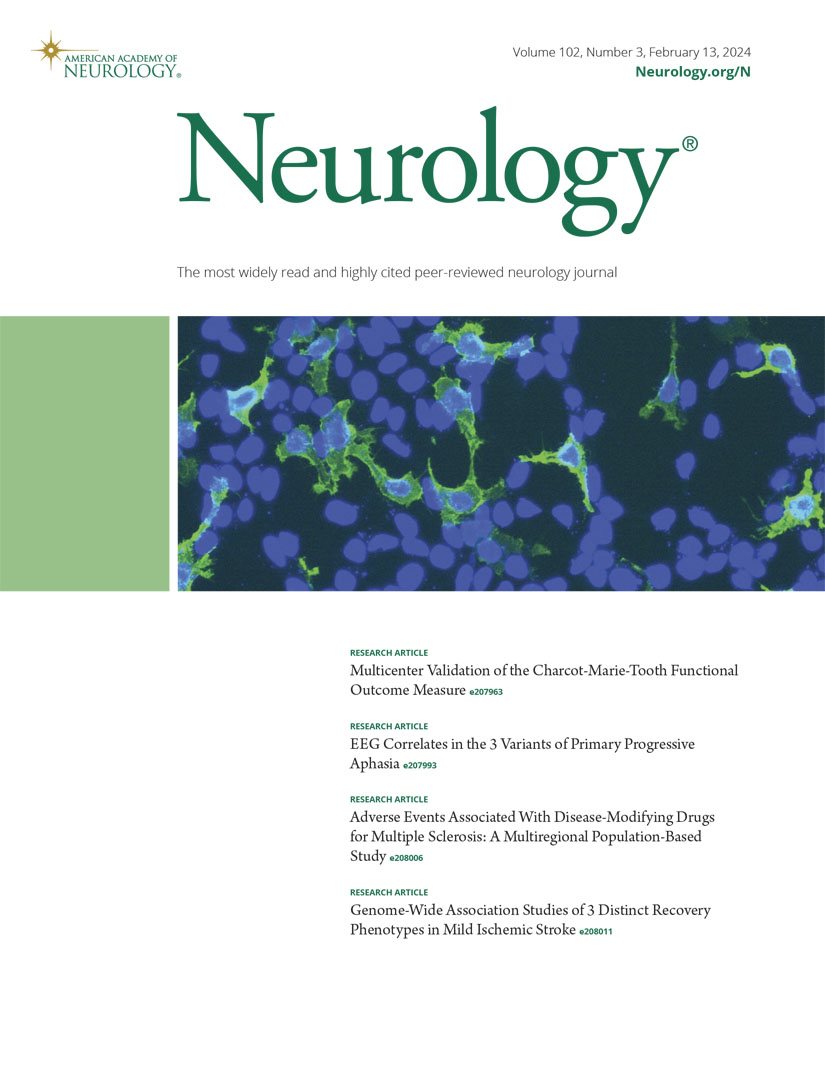Pearls & Oy-Sters: Pan-Neurofascin Nodo-Paranodopathy Presenting as Fulminant Guillain-Barré Syndrome.
IF 7.7
1区 医学
Q1 CLINICAL NEUROLOGY
引用次数: 0
Abstract
Autoimmune nodo-paranodopathy (AINP) associated with antibodies against pan-neurofascin (Ab-PanNF) is a rare subtype of autoimmune neuropathy. It can present as a severe, prolonged, and sometimes fatal disease. However, with appropriate treatment, it generally follows a monophasic course, and many patients achieve complete or near-complete recovery. Antibody-depleting therapy with rituximab (RTX) is currently the best therapeutic option. In this article, we report a patient with progressive weakness who was initially misdiagnosed with Guillain-Barré syndrome (GBS). Intravenous immunoglobulin (IVIg) led to partial improvement, but the patient deteriorated abruptly weeks later, developing tetraplegia, lower cranial nerve involvement, and dysautonomia. Eventually, a diagnosis of AINP with Ab-PanNF was reached, prompting the initiation of RTX. The patient improved dramatically and remains in remission. We discuss the pathophysiology underlying Ab-PanNF-mediated AINP, its clinical and electrodiagnostic features, and considerations regarding antibody testing and treatment. Specifically, red flags that should prompt early Ab-PanNF testing include age older than 60 years, severe and rapidly progressive GBS, prolonged mechanical ventilation, fulminant relapse after initial improvement, and resistance to standard treatments. Finally, we review the literature and summarize the main features of the 40 cases reported so far. Ab-PanNF-mediated AINP is a potentially life-threatening disease; its early recognition is of utmost importance because early antibody-depleting therapy significantly alters outcomes and can be lifesaving.珍珠和y- sters:泛神经束蛋白淋巴结副病表现为暴发性格林-巴勒综合征。
与泛神经束蛋白(Ab-PanNF)抗体相关的自身免疫性结节副神经病(AINP)是一种罕见的自身免疫性神经病亚型。它可以表现为一种严重的、长期的、有时是致命的疾病。然而,通过适当的治疗,它通常遵循一个单相的过程,许多患者实现完全或接近完全的恢复。利妥昔单抗(RTX)抗体消耗疗法是目前最好的治疗选择。在这篇文章中,我们报告了一位最初被误诊为格林-巴-罗综合征(GBS)的进行性虚弱患者。静脉注射免疫球蛋白(IVIg)导致部分改善,但几周后患者突然恶化,发展为四肢瘫痪、下颅神经受累和自主神经异常。最终,诊断为伴有Ab-PanNF的AINP,促使RTX的启动。病人病情显著好转,目前仍处于缓解期。我们讨论了ab - pannf介导的AINP的病理生理学基础,其临床和电诊断特征,以及有关抗体检测和治疗的注意事项。具体来说,应提示早期进行Ab-PanNF检测的危险信号包括年龄大于60岁、严重且快速进展的GBS、延长机械通气时间、最初改善后的暴发性复发以及对标准治疗的抵抗。最后,我们回顾了文献,总结了迄今为止报道的40例病例的主要特征。ab - pannf介导的AINP是一种潜在的危及生命的疾病;它的早期识别是至关重要的,因为早期抗体消耗治疗可以显著改变结果,并可以挽救生命。
本文章由计算机程序翻译,如有差异,请以英文原文为准。
求助全文
约1分钟内获得全文
求助全文
来源期刊

Neurology
医学-临床神经学
CiteScore
12.20
自引率
4.00%
发文量
1973
审稿时长
2-3 weeks
期刊介绍:
Neurology, the official journal of the American Academy of Neurology, aspires to be the premier peer-reviewed journal for clinical neurology research. Its mission is to publish exceptional peer-reviewed original research articles, editorials, and reviews to improve patient care, education, clinical research, and professionalism in neurology.
As the leading clinical neurology journal worldwide, Neurology targets physicians specializing in nervous system diseases and conditions. It aims to advance the field by presenting new basic and clinical research that influences neurological practice. The journal is a leading source of cutting-edge, peer-reviewed information for the neurology community worldwide. Editorial content includes Research, Clinical/Scientific Notes, Views, Historical Neurology, NeuroImages, Humanities, Letters, and position papers from the American Academy of Neurology. The online version is considered the definitive version, encompassing all available content.
Neurology is indexed in prestigious databases such as MEDLINE/PubMed, Embase, Scopus, Biological Abstracts®, PsycINFO®, Current Contents®, Web of Science®, CrossRef, and Google Scholar.
 求助内容:
求助内容: 应助结果提醒方式:
应助结果提醒方式:


